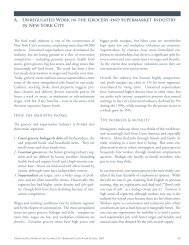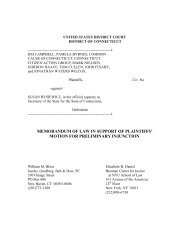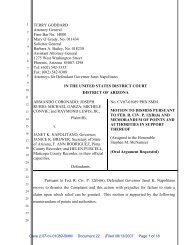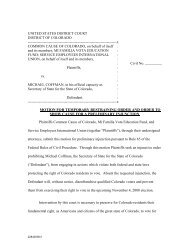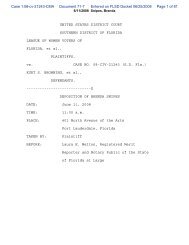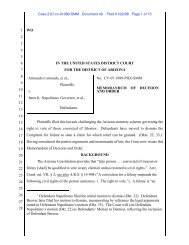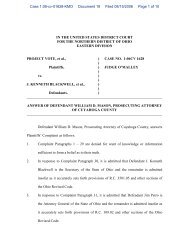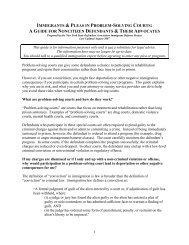Finally, the Department of Justice could create and maintain the database. The Department has similarresponsibilities in other contexts. For instance, the Anti-Car Theft Improvements Act of 1996 212 gavethe DOJ responsibility <strong>for</strong> creating the National Motor Vehicle Title In<strong>for</strong>mation System, a databasedesigned to compile in<strong>for</strong>mation from a variety of sources on the histories of individual motor vehicles.The Act also provided the Department with en<strong>for</strong>cement powers in the event someone required tosubmit in<strong>for</strong>mation to the database failed to do so.C. Analogous RegimesAnalogous regulatory regimes <strong>for</strong> other industries demonstrate the power and usefulness of this kindof regulatory scheme.The clearinghouse we propose is similar in principle to the database that Congress ordered the ConsumerProduct Safety Commission (CPSC) to establish as part of the Consumer Product Safety ImprovementAct (CPSIA) of 2008. 213 One of CPSIA’s key features was Congress’s mandate that the CPSC createa publicly available, searchable database that records in<strong>for</strong>mation from, among others, consumers,government agencies, and healthcare professionals, regarding the harms related to the use of a consumerproduct regulated by the CPSC. 214 A House Committee Report on the legislation states that the “goalof the CPSC should be to devise a database that can rapidly provide consumers with ‘early warning’in<strong>for</strong>mation about specific products that could pose serious safety hazards.” 215The National Highway Traffic Safety Administration (NHTSA) 216 and the Food and DrugAdministration (FDA) maintain similar “early warning” databases. NHTSA’s Early Warning Reportingdatabase collects and makes publicly available property damage reports and death and injury reportsprovided by manufacturers pursuant to the Transportation Recall Enhancement, Accountability, andDocumentation (TREAD) Act of 2000. 217 Meanwhile, NHTSA’s Office of Defects Investigations (ODI)database, even be<strong>for</strong>e the passage of the TREAD Act, has allowed consumers both to make and search<strong>for</strong> safety complaints regarding problems with motor vehicles or pieces of motor vehicle equipment. 218The FDA’s Adverse Event Reporting System, moreover, collects and makes publicly available adversedrug reaction in<strong>for</strong>mation by healthcare professionals and consumers. 219These databases, although not quite as robust and user-friendly as the proposed CPSIA database, haveplayed important roles in protecting the public. Indeed, it was independent analysis of NHSTA’scomplaint database that catalyzed the Bridgestone/Firestone tire recall years ago. 220 And, it was theBridgestone/Firestone recall that was the impetus behind the passage of TREAD. 221In June 2009, researchers mining the NHTSA complaint database discovered the high rate of failure ofChinese valve stems; this ultimately led to the recall of millions of valve stems in vehicle tires. 222 Laterin the year, NHTSA launched an investigation of Toyota vehicles after receiving over 400 consumercomplaints about acceleration problems with the cars; some of these problems appear to have beenresponsible <strong>for</strong> fatal accidents. 223 This investigation led Toyota to announce on November 25 that itwould repair the accelerator pedals on some 4.26 million vehicles. 224 After the first recall, reports ofproblems with Toyota vehicles, which had been steady be<strong>for</strong>e acceleration problems began to receiveattention in the fall, surged. 225 As more customers came <strong>for</strong>ward with complaints, federal investigatorsexpanded the probe to look at other problems with Toyota vehicles, and the company issued additionalrecalls <strong>for</strong> brake and acceleration problems. 226 On April 5, 2010, NHTSA assessed the largest legallypermissible fine against Toyota. In his letter to the company notifying them of the fine, NHTSA ChiefCounsel O. Kevin Vincent identified the manufacturer’s failure to notify authorities in a timely mannerafter becoming aware of the defects as the primary rationale <strong>for</strong> levying the harsh penalty. 22730 | Brennan Center <strong>for</strong> Justice
Results from the FDA’s Adverse Event Reporting System have been no less powerful. For example, in 1998shortly after the System’s launch, reports of liver injuries on the system resulted in the FDA’s removal of theanti-inflammatory drug Duract from the market. 228 More recently, a handful of reports on the system abouta serious condition affecting bone marrow of those taking the antibiotic Zyvox, led to a change to the drug’slabeling to in<strong>for</strong>m providers about the risk of this reaction and recommendations <strong>for</strong> monitoring patients. 229We chose the CPSIA database as a model because it will be the most comprehensive publicly available“early warning” database ever created, and the CPSC has been developing it based upon lessons fromthe NHTSA and FDA databases with a desire to improve upon them by, among other things, makingthem more user-friendly. 230 Indeed, in CPSIA’s legislative history, a House Committee urges the CPSCto “examine these and other Agency ef<strong>for</strong>ts, if applicable, when designing its own database.” 231D. Key BenefitsA database that con<strong>for</strong>ms to the specifications we have outlined would allow the appropriate governmentagency, vendors, and the public to efficiently access, evaluate, investigate, and share in<strong>for</strong>mationregarding voting system failures or vulnerabilities. This, in turn, would result in earlier detection ofsystem failures and vulnerabilities by vendors and election officials, and ensure more rapid responses tothose issues ultimately making it less likely that voting systems will malfunction on Election Day, whenit matters most. More specifically, however, the database would achieve the following objectives:Increase Election Official & Public Awareness ofProblems & Solutionsa national, searchable databaseThe database would allow election officials toeasily access and share in<strong>for</strong>mation. For example, would allow election officials tothis would help to ensure that election officials ineasily access and share in<strong>for</strong>mation.different states using the same make and model ofmachine or other voting system element would beaware of any problems the other had encountered using that equipment – if one official discovers avulnerability and posts this in<strong>for</strong>mation to the database, the other official will be able to check his orher system to ensure that it does not also have that vulnerability. Moreover, if a vendor provides oneelection official with a procedural solution, such as a workaround to address a problem, the databasewould provide officials using the same voting equipment in other jurisdictions with that solution.Further, the database would provide voter protection groups, political parties and other concernedmembers of the public with more knowledge about potential voting system problems. Be<strong>for</strong>e anelection, they would, among other things, be able to determine whether there have been any issueswith the voting systems in their counties and, if so, to advocate corrective action be<strong>for</strong>e the election andbe on the lookout <strong>for</strong> similar problems during voting.Improve the Ability of Government and Others to Identify Failures or Vulnerabilities & Respond QuicklyThe database would allow the appropriate government agency, voter protection groups, and otherconcerned members of the public to mine the in<strong>for</strong>mation on the database and spot patterns and trendsthat may indicate voting system failures or vulnerabilities. This is a key reason <strong>for</strong> allowing individualvoters to report problems they encounter. All of the databases hosted by federal agencies that wereviewed allow such reporting from the general public. After collecting and analyzing this in<strong>for</strong>mation,the appropriate government agency would be able to more quickly launch an investigation to rectifythese potential vulnerabilities or failures.Brennan Center <strong>for</strong> Justice | 31
- Page 5: IV.A BETTER WAY TO TRACK AND ADDRES
- Page 11: 4. Pressure Vendors to Voluntarily
- Page 14 and 15: its newly established Voting System
- Page 16 and 17: iii.failures of the current system:
- Page 18 and 19: 2. Humboldt County, California, Nov
- Page 20 and 21: 4. Pulaski County, Arkansas, May 20
- Page 22 and 23: 7. Florida, June 2004According to t
- Page 24 and 25: Denise Lamb, who currently serves a
- Page 26 and 27: Ms. Poucher has stated that it “w
- Page 28 and 29: Sequoia identified four possible ca
- Page 30 and 31: Had advocates and researchers in Ne
- Page 32 and 33: elative to voting system vendors. A
- Page 34 and 35: or potential vulnerabilities by any
- Page 38 and 39: Provide Timely & Organized Access t
- Page 40 and 41: the CPSC may compel the manufacture
- Page 42 and 43: Civil Division of the Department of
- Page 44 and 45: C. Analogous RegimesCivil penalty p
- Page 46 and 47: Of course, adding these kinds of pr
- Page 49 and 50: v. conclusionVoting is the most imp
- Page 51 and 52: System Vulnerabilities: should incl
- Page 53 and 54: February2008September2004November20
- Page 55 and 56: November2006November2006ES&SiVotron
- Page 57 and 58: June 2008SequoiaOptech 400CCaliforn
- Page 59 and 60: March 2004March 2004DieboldAccuVote
- Page 61 and 62: February2008September2008PremierAcc
- Page 63 and 64: event of an overvote displayed a co
- Page 67 and 68: January 2008January 2008PremierAccu
- Page 69 and 70: November2004ES&SM650FloridaSupervis
- Page 71 and 72: October 2008February2008PremierAccu
- Page 73 and 74: February2008February2008October 200
- Page 75 and 76: 2004 AccuVote 2000ESNovember2008Nov
- Page 77 and 78: November2008November2008Hart InterC
- Page 79 and 80: February2008May 2006August 2004May2
- Page 81 and 82: March 2008June 2009November2008Prem
- Page 83 and 84: February2008November2006SequoiaAVC
- Page 85 and 86: November2008SequoiaImageCastNew Yor
- Page 87 and 88:
November2004November2004UnilectPatr
- Page 89 and 90:
November2008November2008March 2008E
- Page 91 and 92:
May 2008April 2008November2006May 2
- Page 93 and 94:
2006 iVotronicThe Post & Courier re
- Page 95 and 96:
AccuVote TSR6; HartInterCiviceScan;
- Page 97 and 98:
November2006ES&S:iVotronicTexasHida
- Page 99 and 100:
November2003November2009November200
- Page 101 and 102:
October 2008October 2008May 2008ES&
- Page 103 and 104:
appendix c : dupage county election
- Page 105 and 106:
and resolve problems with certified
- Page 107 and 108:
49. E-mail from Carolyn Crnich, Cle
- Page 109 and 110:
95. Kleinberg, supra note 92.96. Ma
- Page 111 and 112:
143. Telephone Interview with Rokey
- Page 113 and 114:
187. Id. at 22.188. See Thomas, sup
- Page 115 and 116:
1801 (“[T]he Secretary shall init
- Page 117 and 118:
258. See United States Department o
- Page 119 and 120:
294. John Archibald & Brett J. Blac
- Page 121 and 122:
334. Jane Musgrave, Palm Beach Coun
- Page 123 and 124:
374. Glitch Keeps Fulton Voters Wai
- Page 125 and 126:
417. Joe Dejka & Chris Olson, A Lat
- Page 127 and 128:
457. Letter from Dave Byrd, Preside
- Page 129:
498. Lauren Glendenning, Voting Gli
- Page 132:
ennancenterfor justiceAt New York U



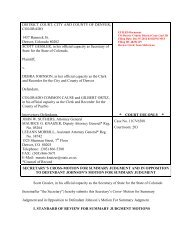
![Download the Letter [PDF] - Brennan Center for Justice](https://img.yumpu.com/50139248/1/190x245/download-the-letter-pdf-brennan-center-for-justice.jpg?quality=85)
